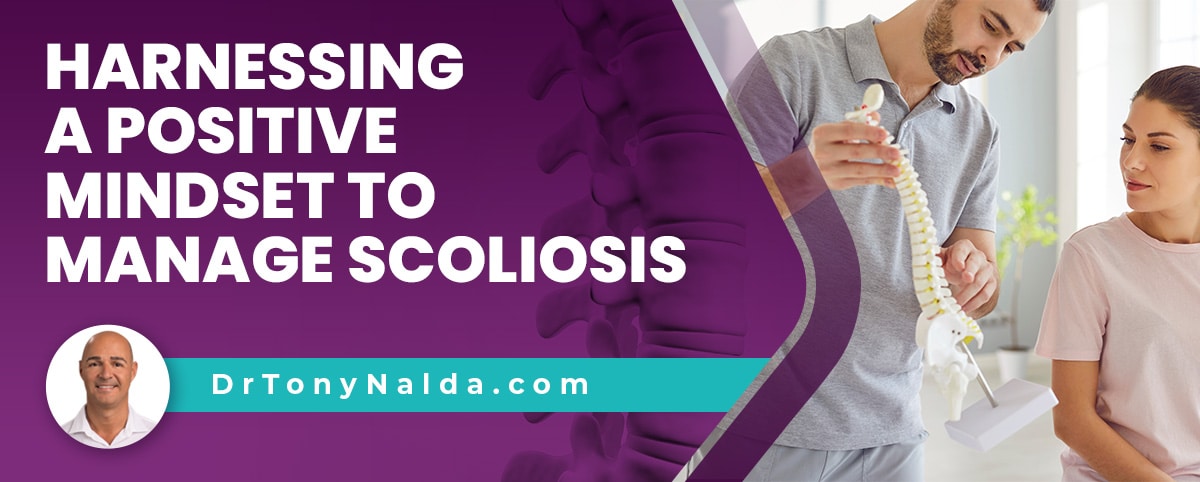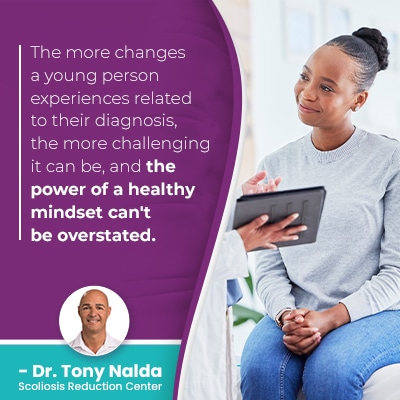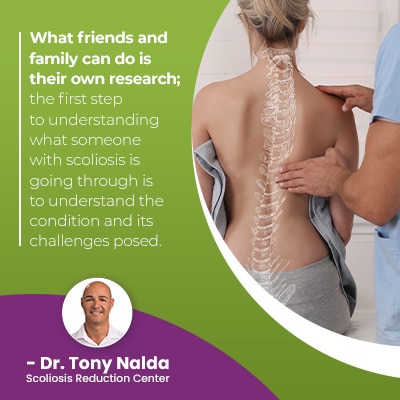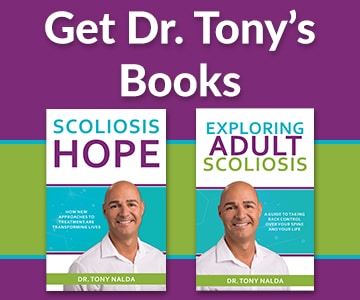Harnessing a Positive Mindset to Manage Scoliosis

When it comes to treating conditions like scoliosis, oftentimes the focus is on physical symptoms, which makes sense as symptom relief is what brings most patients in to see a doctor, but what about the mental health effects? Treating the whole patient involves supporting their mental health.
A positive mindset can help people living with scoliosis in a number of ways. A healthy mindset involves realistic expectations of the condition and scoliosis treatment. A good attitude can help patients stay focused and motivated throughout treatment and beyond.
Before getting to the specific mental health challenges of living with scoliosis and how to cultivate a healthy mindset, let's talk generally about the condition's physical effects.
Table of Contents
How Scoliosis Affects the Body
Scoliosis causes the spine to develop an unnatural lateral curvature that also rotates, making it a complex 3-dimensional condition.
Scoliosis is a structural spinal condition, but its effects can be widespread throughout the body because of its uneven forces.
Scoliosis is also a progressive condition, so its nature is to get worse over time, and this means the size of the unnatural spinal curve is increasing, making its symptoms more severe and noticeable.
The main effect of childhood scoliosis is postural deviation, and this can involve uneven shoulders, uneven shoulder blades, uneven hips, the development of a rib cage arch, and an uneven waist.
As these changes occur, clothing can suddenly seem ill-fitting, and changes to balance, coordination, and gait are also common.
In adult scoliosis, the main symptom is pain, including muscle pain, back pain, and nerve pain that radiates into the extremities.
When it comes to mental health, adolescents are the most at risk for poor mental health related to a scoliosis diagnosis; adolescent idiopathic scoliosis is the most prevalent type overall, so for our current purposes, we'll focus on the power of a positive mindset for adolescents dealing with scoliosis.
Adolescent Idiopathic Scoliosis
Adolescents are the most commonly diagnosed with scoliosis between the ages of 10 and 18, and this age group is the most vulnerable to mental health issues related to age, hormones, and the unpredictable nature of puberty.
Within the context of scoliosis, this age group is also vulnerable to the stresses of the condition because adolescents are the most at risk for rapid-phase progression.
We don't know what triggers idiopathic scoliosis to develop initially, but we know it's growth that triggers progression, and the rapid and unpredictable growth spurts of puberty can make scoliosis worsen quickly.
Even typical adolescents who don't have scoliosis are vulnerable to mental health issues related to body image and self esteem, but imagine a teenager being diagnosed with a progressive spinal condition that's likely to get worse over time and can change the way they look, walk, and move.
The good news is that in many cases, scoliosis can be highly treatable.
Challenges Posed for Adolescents with Scoliosis
The challenges adolescents with scoliosis can face include discomfort, postural changes, movement changes, and activity restrictions.
Each case of scoliosis is unique, so while not every patient will experience activity restrictions, some will.
For adolescents who define themselves by athletic performance and athletic success, if they are told they can no longer participate in their chosen sport/activity, this can cause identity issues and low self esteem.
Not all patients will experience activity restrictions; part of an initial assessment involves communicating which activities are deemed appropriate, which should be approached with causation, and which should be avoided entirely.
Adolescents also have to deal with their bodies changing, and most teenagers don't want to stand apart from their peers; they don't want to look differently and walk differently.
So the more severe a condition is, the more noticeable its symptoms will be, and the more likely it is that activities will need to be modified.
 The more changes a young person experiences related to their diagnosis, the more challenging it can be, and the power of a healthy mindset can't be understated.
The more changes a young person experiences related to their diagnosis, the more challenging it can be, and the power of a healthy mindset can't be understated.
The Power of a Healthy Mindset
Mental health is important for everyone, but for those dealing with the challenges of living and treating a progressive condition like scoliosis, a healthy attitude can help shape a patient's treatment response.
Here at the Scoliosis Reduction Center®, the whole patient is considered in treatment, including their mental health.
A healthy mindset includes realistic expectations of what life with scoliosis can be like, and this can be fostered through clear and open communication with care providers, family, and friends.
It's important that children dealing with scoliosis have a strong support system in place as this can greatly impact their mental health, and having a safe place to process and express fears about their condition can make a significant difference.
Many patients with scoliosis feel powerless, like they can't control what's happening to their bodies, and a change can happen when treatment starts to show results; they can feel like they are regaining control, and this motivates them to fully commit to treatment.
So a positive mindset regarding treatment can help: working towards something positive.
So what can friends and families do to help young people dealing with a scoliosis diagnosis?
How to Support Adolescents With Scoliosis
It can be difficult to know what to say when a young person is struggling to process a recent scoliosis diagnosis, but it's important to provide support.
 What friends and family can do is their own research; the first step to understanding what someone with scoliosis is going through is to understand their condition and its challenges posed.
What friends and family can do is their own research; the first step to understanding what someone with scoliosis is going through is to understand their condition and its challenges posed.
Being informed means also being able to foster realistic expectations about treatment. Some people approach these types of situations with empty words like, "It will be fine." "You'll look exactly the same." "I'm sure nothing will change." The reality, however, is that things likely will change.
Now, a scoliosis diagnosis doesn't mean a life of limitations by any means, and particularly with early detection and intervention, it can be highly responsive and treatable, but there can be challenging moments, particularly at the onset of treatment, before results start to show.
In addition, downplaying what someone is going through in the hopes of being overly positive can feel, to the patient, like it's too hard for you to hear their hard thoughts and feelings, and this can hinder, rather than help establish an open dialogue.
Friends and families want to be a soft supportive place, but support systems also need to have their advice rooted in reality.
A positive slant I do like to introduce to adolescents recently diagnosed, particularly those concerned about athletic performance, is that many celebrities and professional athletes have gone on to fulfill their life's dreams and goals, despite being diagnosed with scoliosis as a child.
Usain Bolt, for example, widely considered to be the greatest Olympic sprinter of all time, was diagnosed as a child and has had to adjust his stride to compensate.
Conclusion
Treatment success can never be guaranteed, but the power of a healthy mindset and attitude can't be overstated.
Scoliosis affects all ages, but is most commonly diagnosed in children, and adolescent idiopathic scoliosis is the condition's most-prevalent type.
Scoliosis can cause physical challenges and changes to posture and appearance; it can also be painful and come with physical activity limitations.
It can be difficult for young people to process the news of being diagnosed with a progressive spinal condition that can get worse with growth.
Scoliosis patients of all ages need to understand the importance of treatment, and treatment options can include invasive spinal surgery or conservative nonsurgical treatment options.
The power of a healthy and positive mental attitude can help with treatment efficacy because positivism is associated with success in basically every area of life, including dealing with the rigors of medical conditions and treatment.
Scoliosis progression can be managed through proactive treatment that impacts conditions on every level, and here at the Scoliosis Reduction Center®, that means combining the power of chiropractic care, physical therapy, scoliosis exercises, corrective bracing and rehabilitation.
Physical therapy sessions can help restore posture and improve/reverse condition effects once the structural nature of the unnatural curve has been addressed through a curve reduction.
As scoliosis symptoms tend to get worse over time, being proactive is key, and as is the case with most progressive conditions, the sooner treatment is started, the better.
Undergoing treatment can also help patients regain feelings of control because they are actually doing something and working towards a positive change.
With the Scoliosis Research Society estimating close to seven million people currently living with the condition in the United States alone, understanding the importance of proactive scoliosis management is important.
Dr. Tony Nalda
DOCTOR OF CHIROPRACTIC
After receiving an undergraduate degree in psychology and his Doctorate of Chiropractic from Life University, Dr. Nalda settled in Celebration, Florida and proceeded to build one of Central Florida’s most successful chiropractic clinics.
His experience with patients suffering from scoliosis, and the confusion and frustration they faced, led him to seek a specialty in scoliosis care. In 2006 he completed his Intensive Care Certification from CLEAR Institute, a leading scoliosis educational and certification center.
About Dr. Tony Nalda
 Ready to explore scoliosis treatment? Contact Us Now
Ready to explore scoliosis treatment? Contact Us Now





